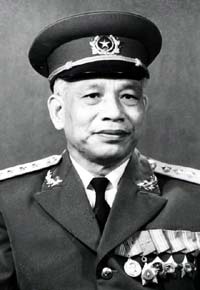(b. May 1, 1917, Co Nhue, Vietnam, French Indochina-d. March 17, 2002, Hanoi)
Van Tien Dung was one of North Vietnam’s greatest war heroes-a peasant soldier who rose to become commander in chief of the North Vietnamese army and lead the final Ho Chi Minh Campaign that captured and occupied Saigon, South Vietnam, in 1975. As a young man, Dung was arrested by French colonial authorities for his Communist Party activities, but he escaped from prison and in 1947 joined Giap’s High Command staff. Despite his lack of military training and limited battlefield experience, Dung proved to be an able logistic planner. He was named chief of staff of the People’s Army of Vietnam in 1953 and succeeded Giap as commander in chief in 1975. After the reunification of Vietnam, he served (1980-87) as defense minister.
Final North Vietnamese Plans 1974-75
In October 1973 DRV leaders had decided on a new offensive in the South with a projected final victory in 1976. Command went not to Giap but to Senior General Van Tien Dung. Giap had been in poor health and was also under attack for the failure of the 1972 offensive, responsibility for which lay with Party Secretary Le Duan. Dung faced formidable problems. The PAVN had suffered serious losses in the 1972 offensive and was short of supplies. The South mirrored this situation. Colonel General (the equivalent of lieutenant general) Tran Van Tra, commander of the southern B-2 Front, noted later, “In 1973 our cadres and men were fatigued, we had not had time to make up our losses, all units were in disarray, there was a lack of manpower, and there were shortages of food and ammunition.”
Tra now recalled PAVN units into the North to be brought up to strength and re-equipped. He also reorganized his command into four corps and strengthened the logistics network through Laos. By the end of 1974 the PAVN was not only in position to fight again, but as historian Cecil Currey notes, “For the first time ever, it could be resupplied fully and in time without depending on prepositioned stockpiles and coolie-borne matériel. It had finally become a modern army.”
In 1974 the fighting intensified. Beginning in March PAVN forces carried out a series of “strategic raids” designed to seize the initiative, gain territory and population, secure supply corridors, sap ARVN strength and morale and heighten PAVN combat effectiveness. Heavy fighting in the Central Highlands was followed by attacks that summer in Quang Ngai, Quang Tin and Quang Nam provinces in northern South Vietnam. From 2 August to 2 September at Plei Me the 410-man 82nd ARVN Ranger Battalion held out against 20 ground assaults and an artillery/mortar onslaught of some 10,000 rounds by the PAVN 320th Division. But ARVN defensive stands were rare and usually the Communist attacks were successful. At the end of the year fighting renewed in the Mekong Delta, and in the second week of December the ARVN lost 706 KIA and 3,758 WIA, the most in any week since the start of the cease-fire. ARVN battle deaths in the entire year ran nearly 31,000; only 1972 was costlier.
In January 1975 ARVN strength on paper came to 465,000 men: 13 divisions (11 infantry, one airborne and one Marine), two independent infantry regiments, 18 armoured squadrons, three motorized squadrons, 43 Ranger battalions and 14 artillery regiments. There were also some 2 million men in paramilitary forces around the country. But the ARVN was characterized by inadequate pay and allowances caused in part by rampant inflation, corruption, a sense of fatalism that the war could not be won and low morale. ARVN’S desertion rate shot up to 24,000 men a month. Thieu also faced daunting political problems as opposition to his rule mounted.
While ARVN was struggling with shortages and manpower losses, PAVN strength was growing. By December 1974 the PAVN had in South Vietnam some 200,000 men, 1,000 armoured vehicles and 600 artillery pieces. PRG/ Viet Cong troops numbered only about 60,000 men.
Le Duan, Le Duc Tho, and other DRV leaders now pushed General Dung to begin the final offensive. Dung was cautious, worried that the United States might intervene with a repeat of 1972. At a meeting with the Politburo in late 1974 he predicted that victory in the South might take several more years. Giap, who still chaired the military committee, told him, “Our planning must provide for the contingency that it [the war] could end in 1975.”
